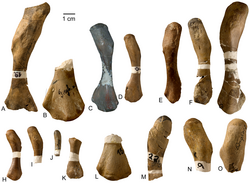| Cymatosaurus Temporal range: Early-Middle Triassic, | |
|---|---|
 | |
| C. erikae holotype skull | |
| Scientific classification | |
| Kingdom: | Animalia |
| Phylum: | Chordata |
| Class: | Reptilia |
| Superorder: | † Sauropterygia |
| Clade: | † Pistosauroidea |
| Family: | † Cymatosauridae |
| Genus: | † Cymatosaurus Fritsch, 1894 |
| Species | |
Cymatosaurus is an extinct genus of pistosauroid or nothosauriform sauropterygian. It is known to have been alive from the Early Triassic to the Middle Triassic period (latest Olenekian to Anisian stages) of Germany and they seem to originate from the Netherlands. [2] [3] It was small to medium-sized for an eosauropterygian, measuring 1–1.2 metres (3.3–3.9 ft) long. [3]







